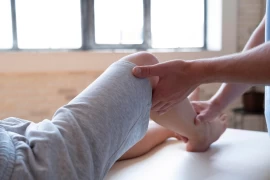
Manual Therapy
- Manual Therapy
- What is Manual Therapy?
- Types of Applications
- Suitability for Different Individuals
- Does Pain Return After Manual Therapy?
What is Manual Therapy?
Manual Therapy is a collection of hands-on applications performed without the need for any devices, particularly in cases related to the musculoskeletal system, following a detailed assessment. Various approaches are adopted by different schools of thought:
- Osteopathic manual therap
- Mulligan Concept
- McKenzie Method
- Chiropractic Treatment
- Fascial Distortion Model
To achieve a high success rate, accurate assessment and purpose-driven applications are essential. Session intervals may vary between 3 to 7 days depending on each individual's specific condition and the type of treatment provided. Session intervals can be extended as severe discomfort decreases. Just as degeneration doesn't occur in a day, expecting complete recovery in one session is not realistic.
The healing process takes time. Manual therapy can alleviate a person's pain quickly, but complete recovery cannot be claimed. It is important to maintain a consistent exercise program to support the treatment applied. To achieve lasting results, it can be beneficial for individuals to see a therapist at regular intervals for adjustments and exercise modifications. Collaboration between the client and therapist is necessary for effective management of the process.
Types of Applications
The choice of which tissue to target, the purpose, and the manner of intervention are determined based on the assessment results. Manual therapy methods vary and require professional assessment for selection:
- Myofascial release
- Mobilizations
- Manipulations
- Frictions
- Trigger point work
- Cupping massages
- Classical massages
- Connective tissue massages
- Functional massages
- Taping
It's worth noting that manipulation videos have gained significant popularity. However, it should be remembered that manipulation is just a part of manual therapy and may not be suitable for every individual. Prior to beginning manual therapy, a personalized assessment should be conducted. Factors such as age, rheumatic conditions, pregnancy status, and prolonged medication use should be considered and a decision should be made accordingly.
After a session, exercises that support the performed applications are taught, and homework is assigned for the individual to practice at home. This approach accelerates and completes the healing process. Nutrition habits, alcohol and tobacco use, and stress management are also crucial during the recovery process, and appropriate guidance should be provided in these areas.

Suitability for Different Individuals
Providing information about whom the treatment is not suitable for can simplify the process. In cases of serious conditions such as fractures, tumors, and significant nerve compression, it is best to avoid touching the patient. There are also individuals who require careful consideration:
- Elderly individuals,
- Children,
- Pregnant women,
- Individuals with rheumatic conditions,
- Those who have used corticosteroids for an extended period,
- Individuals with advanced osteoporosis.
Not every application is suitable for these individuals. Manual therapy can be safely and successfully applied in the following cases:
- Lumbar disc herniation
- Mechanical lower back pain
- Headaches,
- Migraines
- Straight neck
- Cervical disc herniation
- Nerve compression
- Fibromyalgia
- Muscle tears
- All joint issues (knee, hip, elbow, shoulder, wrist, ankle, sacroiliac joint)
- Frozen shoulder
- Plantar fasciitis
- Scoliosis
- Fascial tensions
- Carpal tunnel syndrome
- Meniscus lesions
- Ligament injuries
- Limitations due to immobilization after fractures
Manual therapy, combined with customized exercise programs, can also be effective in addressing the most common herniation issues. Contrary to common belief, herniations are not permanent and can be treated with appropriate approaches. Furthermore, the scope of manual therapy extends to various areas such as pregnancy-related back pain, muscle spasms, pelvic floor issues in women, and neurological disorders.
Does Pain Return After Manual Therapy?
For it to not recur, the tissue must fully heal. At this point, the criterion is not merely the absence of pain; rather, it is the completion of a full healing process. While the disappearance of pain indicates the initiation of healing, this process is not yet complete. During this stage, the healing tissue may be weaker. Stimulus must be provided to promote the tissue's transformation into a healthy and strong state. If a full and healthy recovery is not achieved, there is a risk of re-injury or re-initiation of the process even with minor loading or trauma. Therefore, engaging in exercise, maintaining a balanced diet, and managing stress well are important for a healthy recovery. This way, the tissue can regain a solid structure and achieve a healthy healing process. It should be remembered that each tissue may require different forms of stimulation.
When dealing with cartilage tissue, compression is required, while connective tissue demands tension. Therefore, selecting personalized exercises for each individual and the affected tissue is crucial. Transitioning from generic exercise prescriptions to personalized exercise programs is a more accurate approach. By implementing appropriate loading strategies, an individual's loading capacity can be increased. Consequently, individuals who receive manual therapy can reduce the risk of injuries during sports activities, avoid herniation when lifting heavy objects, minimize discomfort associated with desk work, and experience improved mobility during daily activities.
The pandemic has made it evident that staying confined indoors and being inactive can have detrimental effects on the body. Engaging in proper loading is essential for a healthy lifestyle. After the age of thirty, exercise becomes the most effective way to counteract the gradual deterioration of the body. Children experience peak tissue renewal and development, while tissue regeneration becomes more challenging as one ages, particularly during the transition from childhood to adolescence.





